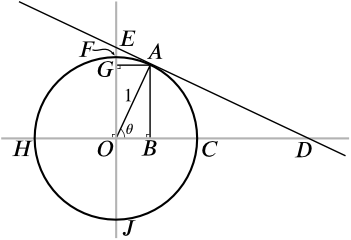Or search by topic
Number and algebra
Geometry and measure
Probability and statistics
Working mathematically
For younger learners
Advanced mathematics
Have a Sine
Age 16 to 18
Challenge Level 





- Problem
- Student Solutions
The trigonometric functions with which we are most familiar are sine and cosine. From them, we can obtain tangent, and also the reciprocals secant, cosecant and cotangent.
In the past, mathematicians have used many other trigonometric functions too. Some of these are illustrated below.

Find the following lengths, in terms of $\sin\theta$ and $\cos \theta$.
- $OB$
- $AB$
- $BC$ (this was known as the versed sine or versine of $\theta$, written $\mathop{\mathrm{versin}}\theta$)
- $OD$
- $CD$ (this was known as the exsecant of $\theta$, written $\mathop{\mathrm{exsec}}\theta$)
- $AD$
- $AE$
- $AG$
- $GO$
- $FG$ (this was known as the coversed sine or coversine of $\theta$, written $\mathop{\mathrm{coversin}}\theta$ or $\mathop{\mathrm{covers}}\theta$ or $\mathop{\mathrm{cvs}}\theta$)
- $EF$ (this was known as the excosecant of $\theta$, written $\mathop{\mathrm{excosec}}\theta$ or $\mathop{\mathrm{excsc}}\theta$)
Can you find line segments on the diagram that have the following lengths?
- The versed cosine or vercosine of $\theta$, written as $\mathop{\mathrm{vercos}}\theta$, which is defined by $$\mathop{\mathrm{vercos}}\theta = 1 + \cos\theta$$
- The coversed cosine or covercosine of $\theta$, written as $\mathop{\mathrm{covercos}}\theta$, which is defined by $$\mathop{\mathrm{covercos}}\theta = 1 + \sin\theta$$
We know that $\cos\theta = \sin\left(\frac{\pi}{2} - \theta\right)$.
- How are versine and coversine related?
- How are vercosine and covercosine related?
- What do you think that the prefix "co-" might indicate here?
This is an Underground Mathematics resource.
Underground Mathematics is hosted by Cambridge Mathematics. The project was originally funded by a grant from the UK Department for Education to provide free web-based resources that support the teaching and learning of post-16 mathematics.
Visit the site at undergroundmathematics.org to find more resources, which also offer suggestions, solutions and teacher notes to help with their use in the classroom.
Underground Mathematics is hosted by Cambridge Mathematics. The project was originally funded by a grant from the UK Department for Education to provide free web-based resources that support the teaching and learning of post-16 mathematics.
Visit the site at undergroundmathematics.org to find more resources, which also offer suggestions, solutions and teacher notes to help with their use in the classroom.


